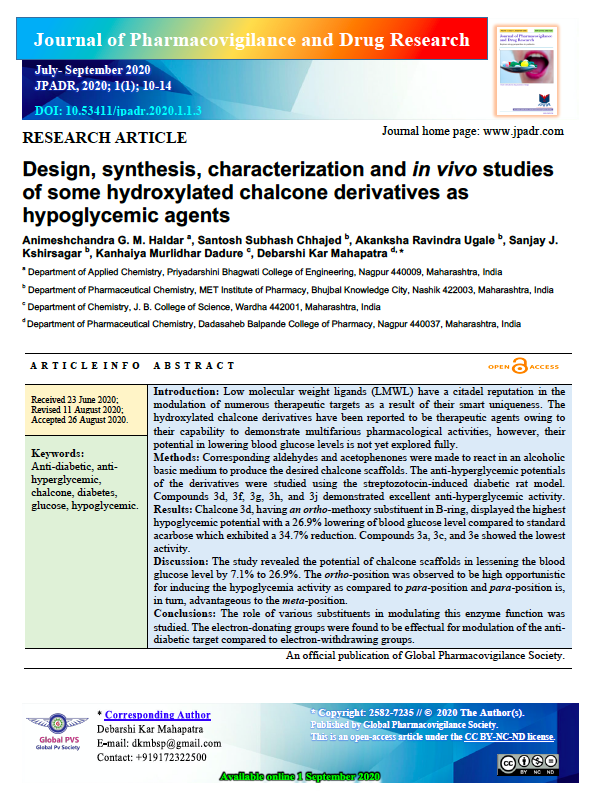Design, synthesis, characterization and in vivo studies of some hydroxylated chalcone derivatives as hypoglycemic agents
Abstract
Introduction: Low molecular weight ligands (LMWL) have a citadel reputation in the modulation of numerous therapeutic targets as a result of their smart uniqueness. The hydroxylated chalcone derivatives have been reported to be therapeutic agents owing to their capability to demonstrate multifarious pharmacological activities, however, their potential in lowering blood glucose levels is not yet explored fully.
Methods: Corresponding aldehydes and acetophenones were made to react in an alcoholic basic medium to produce the desired chalcone scaffolds. The anti-hyperglycemic potentials of the derivatives were studied using the streptozotocin-induced diabetic rat model. Compounds 3d, 3f, 3g, 3h, and 3j demonstrated excellent anti-hyperglycemic activity.
Results: Chalcone 3d, having an ortho-methoxy substituent in B-ring, displayed the highest hypoglycemic potential with a 26.9% lowering of blood glucose level compared to standard acarbose which exhibited a 34.7% reduction. Compounds 3a, 3c, and 3e showed the lowest activity.
Discussion: The study revealed the potential of chalcone scaffolds in lessening the blood glucose level by 7.1% to 26.9%. The ortho-position was observed to be high opportunistic for inducing the hypoglycemia activity as compared to para-position and para-position is, in turn, advantageous to the meta-position.
Conclusions: The role of various substituents in modulating this enzyme function was studied. The electron-donating groups were found to be effectual for modulation of the anti-diabetic target compared to electron-withdrawing groups.
Downloads
References
Borikar, S. P., Kallewar, N. G., Mahapatra, D. K., Dumore, N. G. (2018)a. Dried flower powder combination of Clitoria ternatea and Punica granatum demonstrated analogous anti-hyperglycemic potential as compared with standard drug metformin: In vivo study in Sprague Dawley rats. Journal of applied pharmaceutical science, 8(11), 75-79.
Borikar, S. P., Kallewar, N. G., Mahapatra, D. K., Dumore, N. G., Danao, K. R. (2017). Combined flower decoction of Clitoria ternatea and Punica granatum expressed comparable hypoglycemic activity with that of metformin: In vivo study. International journal of pharmaceutical science and research, 2(5), 4-7.
Borikar, S. P., Kallewar, N. G., Mahapatra, D. K., Gupta, R. A., Dumore, N. G., Danao, K. R., Mahajan, U. N. (2018) Decoction of Andrographis paniculata whole plant and Gymnema sylvestre leaves demonstrated noteworthy hypoglycemic activity in Sprague Dawley rat. The journal of phytopharmacology, 7(1), 84-87.
Chhajed, S. S., Chaskar, S., Kshirsagar, S. K., Haldar, G. M., & Kar Mahapatra, D. (2017). Rational design and synthesis of some PPAR-γ agonists: Substituted benzylideneamino-benzylidene-thiazolidine-2,4-diones. Computational biology and chemistry, 67, 260–265.
Gangane, P. S., Kadam, M. M., Mahapatra, D. K., Mahajan, N. M., Mahajan, U. N. (2018). Design and formulating gliclazide solid dispersion immediate release layer and metformin sustained release layer in bilayer tablet for the effective postprandial management of diabetes mellitus. International journal of pharmaceutical science and research, 9(9), 3743-3756.
Godbole, M. D., Mahapatra, D. K., Khode, P. D. (2017). Fabrication and Characterization of Edible Jelly Formulation of Stevioside: A Nutraceutical or OTC Aid for the Diabetic Patients. Inventi rapid nutraceuticals, 2017(2), 1-9.
Kuhite, N. G., Padole, C. D., Amdare, M. D., Jogdand, K. R., Kathane, L. L., Mahapatra, D. K. (2017). Hippuric acid as the template material for the synthesis of a novel anti-diabetic 1,3,4-thiadiazole derivative. Indian journal of pharmaceutical and biological research, 5(3), 42-45.
Mahapatra, D. K., & Bharti, S. K. (2016). Therapeutic potential of chalcones as cardiovascular agents. Life sciences, 148, 154–172.
Mahapatra, D. K., Asati, V., & Bharti, S. K. (2015). Chalcones and their therapeutic targets for the management of diabetes: structural and pharmacological perspectives. European journal of medicinal chemistry, 92, 839–865.
Mahapatra, D. K., Bharti, S. K., & Asati, V. (2015) a. Anti-cancer chalcones: Structural and molecular target perspectives. European journal of medicinal chemistry, 98, 69–114.
Mahapatra, D. K., Bharti, S. K., & Asati, V. (2015) b. Chalcone scaffolds as anti-infective agents: structural and molecular target perspectives. European journal of medicinal chemistry, 101, 496–524.
Mahapatra, D. K., Bharti, S. K., & Asati, V. (2017). Chalcone Derivatives: Anti-inflammatory Potential and Molecular Targets Perspectives. Current topics in medicinal chemistry, 17(28), 3146–3169.
Mahapatra, D. K., Bharti, S. K., Asati, V. (2019). Recent perspectives of chalcone based molecules as protein tyrosine phosphatase 1B (PTP-1B) inhibitors. In: Mahapatra DK, Bharti SK, Editors. Medicinal Chemistry with Pharmaceutical Product Development. New Jersey: Apple Academic Press, 2019, 235-251.
Mahapatra, D. K., Chhajed, S. S., Shivhare, R. S. (2017) a. Development of Murrayanine-Chalcone hybrids: An effort to combine two privilege scaffolds for enhancing hypoglycemic activity. International journal of pharmaceutical chemistry and analysis, 4(2), 30-34.
Mahapatra, D. K., Dadure, K. M., Haldar, A. G. M. (2018). Uracil substitution on a hippuric acid containing 1,3,4-thiadiazole scaffold: The exploration of the anti-hyperglycemic potential. International journal of medical science in clinical research and review, 1(2), 1-4.

Copyright (c) 2020 Animeshchandra G. M. Haldar, Santosh Subhash Chhajed, Akanksha Ravindra Ugale, Sanjay J. Kshirsagar, Kanhaiya Murlidhar Dadure, Debarshi Kar Mahapatra

This work is licensed under a Creative Commons Attribution-NonCommercial-NoDerivatives 4.0 International License.









